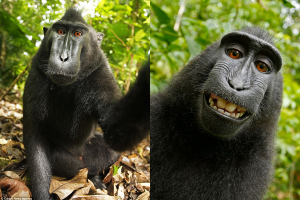 The monkey selfie is back. Again. This time in an improbable lawsuit for copyright infringement filed by an improbable plaintiff, People for the Ethical Treatment of Animals (PETA), on behalf of the improbable photographer—an Indonesian crested Macaque named, according to the complaint, Naruto.
The monkey selfie is back. Again. This time in an improbable lawsuit for copyright infringement filed by an improbable plaintiff, People for the Ethical Treatment of Animals (PETA), on behalf of the improbable photographer—an Indonesian crested Macaque named, according to the complaint, Naruto.
The backstory is that Naruto was minding his own business on the wildlife reserve where he lives when he happened upon an unattended camera belonging to the wildlife photographer David Slater. Intrigued by his discovery, Naruto grabbed the camera and snapped a few photos, including the now famous shot (reproduced at left) of his handsome, grinning face. The photo’s inaugural turn in the global press and as an Internet meme was back in 2011, when Slater first released the shots of Naruto to the media along with the story of their surprising origin. Caters News Agency published a full-body shot (also reproduced at left) with a caption asserting that it owned copyright in the photo, introducing two legal questions: Are these photos subject to copyright? If so, who owns the copyright in them?
The two questions reared their head (if you will) again in 2014, when Wikimedia announced in its transparency report that Wikimedia Commons had published the headshot and received a DMCA takedown notice from Slater. Wikipedia refused to take down the photo, arguing that a photo taken by a monkey is not subject to copyright and is, therefore, in the public domain for anyone to reproduce and distribute. Slater didn’t press the issue, and now PETA has turned the tables on him, alleging in its complaint that he has infringed Naruto’s copyright by publishing the photo along with Naruto’s other selfies in a book called Wildlife Personalities. PETA’s provocative legal argument is that Naruto should be treated for copyright purposes as the author of a protected original work:
Naruto has the right to own and benefit from the copyright in the Monkey Selfies in the same manner and to the same extent as any other author. Had the Monkey Selfies been made by a human using Slater’s unattended camera, that human would be declared the photographs’ author and copyright owner. While the claim of authorship by species other than homo sapiens may be novel, “authorship” under the Copyright Act, 17 U.S.C. § 101 et seq., is sufficiently broad so as to permit the protections of the law to extend to any original work, including those created by Naruto.
The question, of course, is whether copyright authorship is, as both a practical and a doctrinal matter, as broad as PETA would like it to be. A similar question arises with respect to the increasingly interesting and sophisticated artistic works that are being created autonomously by AI software. (If you’re interested in that problem, I’ve written at length about it here.) The answer is that copyright authorship both is and isn’t broad enough to encompass works created by non-human authors. It is sufficiently broad in the sense that corporations, which are legal but not natural persons, are treated as authors under the work made for hire doctrine. Given copyright law’s accommodation of “authorship by corporation,” it isn’t as if non-human authors are legally unprecedented. Copyright law probably isn’t sufficiently broad, however, considering the extent to which the case law defining authorship tacitly assumes not only volition on the part of the agent who “fixes” a copyrighted work, but also human personality and intellectual endeavor. After all, corporations may be authors, but they are only nominal authors of works created by natural persons.
PETA faces several obstacles in its case. The first is the threshold issue of whether it has legal standing to assert Naruto’s putative copyright. Then, there is the hurdle of convincing the court as a factual matter that Naruto was acting with creative purpose when he operated the camera. Copyright law cares about creative incentives, and it’s hard to imagine that Naruto was responding to any such incentives when he took his selfies. Related to the incentive question, PETA faces the likely insurmountable hurdle represented by the powerful assumption underlying over 100 years’ worth of copyright precedents that authorship is a function of human ingenuity. That assumption is worth examining in light of evolving technologies like AI and robotics, but it is unlikely to get a very close look in this case.
PETA’s agenda in this case clearly goes beyond copyright law and its definition of authorship. The point of the case is to try to move the needle, however incrementally, in courts of law and the court of public opinion, toward acceptance of animal agency and personality. Seen in this context, the monkey selfie case is part of a much broader effort to advance animal rights in general and the “great ape personhood” movement specifically. The most traction the movement has gotten in the United States came last April when a New York state court judge issued a writ of habeas corpus to two captive research chimps at SUNY Stonybrook, effectively recognizing them as legal persons. The court later amended its order, however—a sign of the judge’s discomfort with the order’s broader implications.




